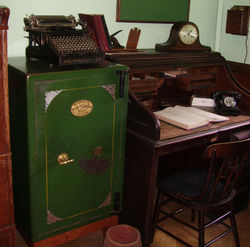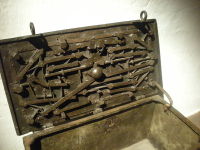Safe: Difference between revisions
mNo edit summary |
mNo edit summary |
||
| Line 61: | Line 61: | ||
* [[Key]] | * [[Key]] | ||
* [[Security_Ratings|Security Ratings]] | * [[Security_Ratings|Security Ratings]] | ||
{{Stub}} | |||
[[Category:Safes]] | |||
Revision as of 15:53, 15 June 2009
Safe
A safe (or coffer, strongbox) is a lockable enclosure used for storing valuables against theft or damage. Safes provide burglary or environmental protection but rarely excel in both. Likewise, the security rating of a safe is divided between burglary and environmental protection categories.
Vaults and strongrooms are essentially large safes, though their construction and security needs are different.
History
Safes have existed in various forms for thousands of years. As with locks, it wasn't until the late 1700s that security became the primary concern. Prior to this, the design and manufacturing of a safe was, for the most part, an artistic endeavor. The history of safes and their advancement closely parallels advances in metallurgy and the design of locks.
Ancient and medieval safes were built of wooden chests, with later versions bound by iron bands. These early safes were mostly artistic, often having detailed carvings and precious materials inlaid on their surfaces. Many safes of this era were markedly complex, with some having several dozen locking bolts. Despite their complexity, most could be easily picked or forced open.
As safes became heavier and more complex, the upward opening chest model became too difficult to open and close. Safes transitioned to outward swinging doors mounted to the side of the container. Safes began to use to full metal bodies, first with iron and then steel. Safes became wood completely encased in metal sheets that were riveted together, then full metal safes that were poured or molded to shape.
The refinement of metallurgy techniques led to the combination of additional metals with steel. These combinations strengthened the steel in many ways. Copper, for example, can be used to provide heat transfer or corrosion resistance. In the early 1800s, fire-resistant safes were introduced. Prior to this safes did not protect against fire, and often helped destroy valuables stored within by being made of heat conductive materials. Though a patent was filed by Richard Scott in 1801 for fire-proofing a safe, it does not appear that it was put to use.
Burglary Safes
Add to me!
Fire Safes
A fire-resistant safe is is designed to protect contents from high temperatures or actual fire. Fire resistant safes are usually rated by the amount of time they can withstand extreme temperatures while not exceeding a set internal temperature. Models are typically available that resist heat between half-hour and four-hour durations.
In the USA, Both the standards writing and testing of fire-resistant safes is performed by Underwriters Laboratories.
Vaults and Strongrooms
Add to me!
Compromise of Safes
- See Safecracking.
See also
| This article is a stub. You can help Lockwiki by expanding it. |



